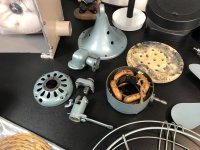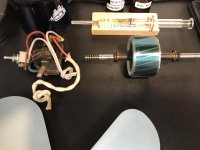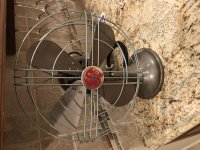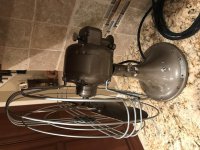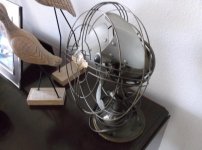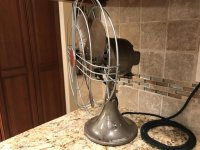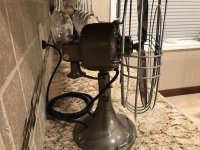- Joined
- Apr 4, 2006
- Messages
- 19,363
- Reaction score
- 30,336
One of my hobbies is buying vintage electric fans and restoring them. They are becoming very hard to find these days - in any sort of descent shape for a reasonable price.
Anyway, I wanted one for my kitchen - even though we have Central Air in the house. There are many times that the temperature outside in not hot and the a/c is off but Mrs. Chief38 is busy cooking away. A fan sure helps out! Plus - I love nostalgic items!!
I bought this fan and the original color was turquoise blue blechhh! It was rusted, stained, had a bent grill and the motor ran very sluggishly. I spent one day tearing it apart, cleaning and straightening things out. Another day to paint it - I used Hammered Rustoleum paint (for the first time ever) and I was quite impressed. It gives a great nostalgic hammered look and very closely duplicates items from that era (1938). It also covered completely in only one coat!
i
Anyway, the 3rd day I rewired and reassembled it and I am quite pleased! Not bad for 80 years old . It is now a Hammered Copper which matches my kitchen perfectly and the damned thing works like new!
. It is now a Hammered Copper which matches my kitchen perfectly and the damned thing works like new!
Anyway, I wanted one for my kitchen - even though we have Central Air in the house. There are many times that the temperature outside in not hot and the a/c is off but Mrs. Chief38 is busy cooking away. A fan sure helps out! Plus - I love nostalgic items!!
I bought this fan and the original color was turquoise blue blechhh! It was rusted, stained, had a bent grill and the motor ran very sluggishly. I spent one day tearing it apart, cleaning and straightening things out. Another day to paint it - I used Hammered Rustoleum paint (for the first time ever) and I was quite impressed. It gives a great nostalgic hammered look and very closely duplicates items from that era (1938). It also covered completely in only one coat!
i
Anyway, the 3rd day I rewired and reassembled it and I am quite pleased! Not bad for 80 years old
Attachments
Last edited:

